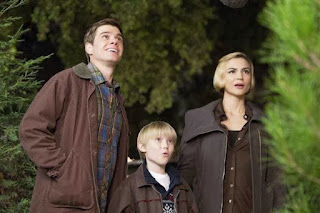Parents and Gender in Holiday Romance Movies
It's December, which means winter holidays, cold weather, hot cocoa, cheery music, and hastily-made Christmas movies on every channel! It's been a fun annual tradition with my family to watch those cheesy holiday romances, the kind that you can find airing almost every hour on Hallmark or Lifetime Channel. In fact, Hallmark has made such movies a part of their brand since its first popular Christmas movie in 2006. They've been releasing around 40 new holiday movies a year for the past few years, with Lifetime channel releasing 26 this year and other years releasing closer to 20. And that's not even counting the many copycats from Netflix, Hulu, HBO, and several other smaller film companies. It's what the podcast American Hysteria amusingly calls the Christmas Movie Industrial Complex.
The holiday romance movie has become a staple for many families, and, with so many churned out each year, it's fascinating to think about the messages and through-lines between them. This year, as a new parent, I was especially curious about how these holiday movies choose to depict parenthood.
Now, parents of adult children are in almost all of these movies; their main goal is to express concern that their kids aren't married, to wish that that their adult child would join them for the holidays, or to give some sage advice or magical family Christmas ornament at just the right time. The parents in these situations are often more of a type than full flushed-out characters. In these made-for-TV movies, it's really only the main leads who get much character development.
Therefore, if I'm looking at holiday-movie leads who are parents, I'm mostly looking at Hallmark, Lifetime, et al.'s depiction of single parents. After all, the whole idea of these movies are that they are romances. (There is one Hallmark movie this year where the main characters are already married, but they are childless and that is a notable exception to the typical holiday romance rule.)
When I set out to see what messages were repeated and depicted in this context, I was shocked to find consistency in many themes and tropes.
 |
| My Santa (2013) |
On the whole, if the female lead is a parent, she is divorced, sometimes abandoned very early in her child's life. There is often a discussion about child-support payments not arriving, and the female lead is often stressed about how to make Christmas special for her child. In 2013's My Santa, single-mother Jen tries to make the holidays magical for her son and to do all the holiday events with him, but secretly has "lost the Christmas spirit" herself. As she explains to the male lead (who is secretly the son of Santa Claus, because of course he is), she had some happy memories of Christmas as a child, but now as an adult "what I remember most about Christmas is being left with an infant because my husband walked out on us." Similarly, in 2018's Every Other Holiday, the mother is shown as stressed and not enjoying the winter holidays herself, instead focusing on buying presents and trying to make Christmas special for her two daughters. "I'm just trying to give them the Christmas they want," she explains in a stressed tone.
The single-mothers are typically shown as stressed-out, responsible, and not enjoying Christmas, even as they do everything they can to keep the holidays fulfilling and magical for their children. The plot then usually involves a working-class, child-at-heart, or magical male lead to show her that Christmas can be magic again for her as well. He drags live-Christmas trees into her house without her permission, decorates her house, or brings little gifts that help remind the mother character of Christmas magic. Even Lifetime's mini-movie, Delivering Christmas, manages to make this plot happen in about 11 minutes: a single-mother who doesn't have the spirit if Christmas needs to be reminded of holiday fun by a series of thoughtful and silly gifts from their local (and attractive) mailman.
Sometimes the movie lampshades that the mother's lack of enjoyment versus the male lead's is rooted in a legitimate reason. In 2008's Most Wonderful Time of the Year, when the attractive, vagabond male-lead tells the single-mom of the movie that she's "doing Christmas all wrong," she at least gets a speech where she points out all of the different types of labor she has to do in comparison to the single-man: "It must be wonderful to have no responsibilities!" she retorts notably. This lampshading, though, only casually calls attention to what kind of help the mother might need, things that might reduce her stress not just during the holidays but during other times as well. Other than a romantic relationship, the status of each woman's life is usually (though not always) largely unchanged by the end of the movie. Sometimes the mother gets a promotion at work that will pay more and sometimes there's a magical gift or prize money that will temporarily make life easier, but more often than not her situation at the end of the movie is not significantly different from the movie's beginning... other than the mother having a more carefree, more childlike, or even magical boyfriend.
This is notable especially because of the jobs that these mothers are usually shown having; while a small percentage are written to be in higher-paying or creative professions, four of the movies with single-mothers that I watched this year had mothers working in the service industry as waitresses, and at least half of those mothers were noted to have given up their "dreams" in order to support their children with their waitressing job. And every movie with a single-mother I watched had a discussion about how the father wasn't paying child-support either on time or at all. While, by the end of the movie, the mother may say something like "maybe I didn't have to stop believing in magic," there isn't often an economic or social change that makes her overall life easier. This is also (sometimes it seems unintentionally) shown in how the custody and parenting divisions are depicted in the movies. Since a majority if not all of the mothers in these films are divorced, many of the films mention custody agreements. In some movies, the father is noted to have left all together when the child was a baby and still stays out of contact, but in others it is clear that custody is shared. In movies like Noel Next Door (2022) and Every Other Holiday (2018), it's implied that in the custody between parents is almost exactly 50-50. However, in both films, only the mother's parental labor is shown. The mother leads are shown arranging baby-sitters, tucking kids into bed, navigating children's acting out, and giving advice; if the fathers are present, they get to contrast with the mother by either being an antagonist figure or the "fun" parent who has a young girlfriend and fewer stresses and responsibilities.
 |
| Noel Next Door (2022) |
This depiction of women's labor is especially interesting when contrasted with the single-fathers in these Christmas movies. On the whole, the single-fathers are all widowed. In movies like Dear Santa (2011), Deliver By Christmas (2020), The Christmas High-Note (2020), Falling for Christmas (2022), and Christmas with You (2022), the fathers are all single parents because their wives have passed away, sometimes several years ago and other times recently enough that this is the first Christmas the family is spending without her. The children in the movies usually are proud of all the work their dad does and wish for him to date again, maybe even making it their Christmas wish. In Dear Santa (2011) for example, the child literally writes a letter to Santa to ask him to find a new love-interest for her father.
In these movies, single-fathers aren't shown struggling with money or custody; the carpenter work or music teaching that the father does seems to pay the bills just fine. The father may be depicted as sad and lonely, but not really stressed. The emotional labor from the paralleled single-mother films doesn't seem to be as much of an issue for these dads; instead, the memory of their nearly-angelic wife seems to (posthumously) do a lot of work. They're are often reflections in these movies about how much the late mother loved Christmas, how proud she'd be of the child performing in his or her first Christmas pageant or what have you. The late mother is also often depicted as an ideal; she may have been "the kindest" person and the one who made the holidays "the most magical," she she may even have run a soup kitchen or community center for those in need. After that idyllic angel is taken away both from him and his child, the single-father must be made happy by a famous pop star, a socialite, or an industrious baker now at Christmas.
There is significantly less domestic and emotional labor shown in the single-father movies; this may also be because the single-father often has a female relative (sister, mother, or aunt) who has been helping out with domestic tasks or childcare. It's not the single-father character who needs to learn a lesson at Christmas in these movies. As Kayleigh Day mentions in her article for Stylist, the single-father movies focus very little on either the father's parenting or the complexity of who the late-mother was. Instead, the single-fatherhood of the male lead serves as a kind of shorthand, as "very real evidence that another woman pre-vetted our male love interest and decided his genetic material was worth passing on. Which means that he was, at least once, capable of a meaningful relationship... [and] able to handle grown-up responsibilities." Thus, in these movies, it is usually the female love interest who has to grow, to put aside her frivolous ways or demanding career in order to be the kind of partner the widowed father needs.
In this blog, I've written before about how media and movies depict the unequal division of parenting, and it's certainly interesting to me that these television Christmas romances reflect some similar ideas. These films reveal some of the expectation gaps with mothers and fathers, what emotions are associated with different genders and parental roles... and how much these Christmas movies recycle similar plot-points.




Comments
Post a Comment